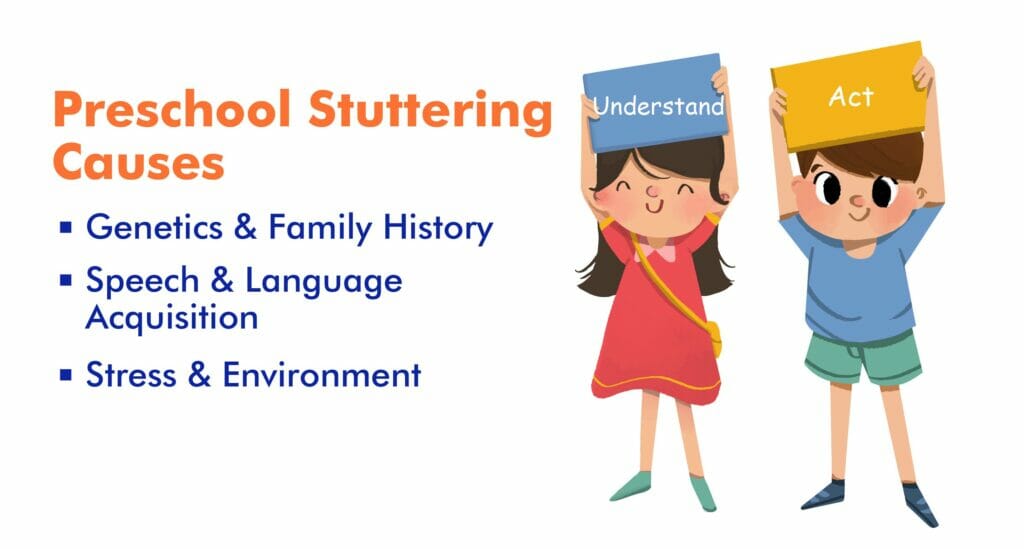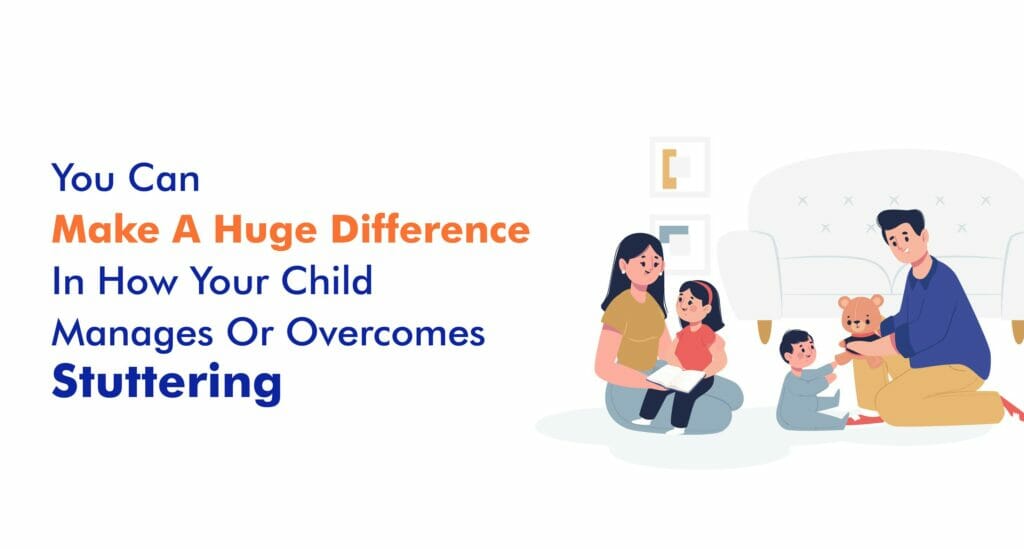Up to 5% of preschoolers between the ages of 2 and 5 stutter. It is typically a short phase for most children that they outgrow within about 6 months.
Experts say that children rapidly learn new words and syntaxes of a language at this age. That may contribute to some disruptions that we also call disfluencies or stuttering in preschool kids.
Many children shuttle back and forth between periods of fluency and disfluency during this time.
Sometimes, these periods of disfluency are preceded by stress, anxiety, fear and tedium. While at other times, they are unprovoked by external stimuli. That makes it superbly worrisome for the parents.
If you have noticed disruptions in your child’s speech, you may have been wondering if it’s due to their rapid language acquiring process, or if your child is truly developing a stuttering problem. And you are not wrong to be worried.
Is Your Preschool Kid Stuttering?
For most toddlers, the period of disfluency is transient. It goes away in less than half-a-year!
If it has been less than 3 to 6 months, we suggest that you give your worries a temporary rest and observe the type of disfluencies in your child’s speech.
You can still consult a speech-language pathologist (SLP) to rule out stuttering and other long-lasting speech disfluencies.
Sometimes, disfluencies don’t disappear but become more prominent over the 6 month period. The signs of stuttering in children become more obvious as the days go by.
That’s when you should consult an SLP to explore the potential stuttering treatments for preschool kids.
Risk Factors for Stuttering in Preschool Kids
Is your child exposed to the risk factors that increase the chances of stuttering in preschool-aged kids?
Some factors can make a child more predisposed to stuttering than others.
Listed below are the most common risk factors for stuttering in preschool kids:
1. Family history: If one or both of the parents stutter, there’s a good chance that the child will continue to stutter into their adulthood.
2. Gender: Boys are more likely to stutter than girls.
However, if your girl child has been stuttering for over a year without any signs of self-recovery, there’s a good chance she will have the speech disfluency for life unless a professional speech therapist intervenes.
3. Other disorders: Stuttering has been associated with other disorders including Autism Spectrum Disorder, Attention Deficit Disorders, learning disabilities and literacy disorders.
If your child has been diagnosed with any of the disorders mentioned here or otherwise, you need to consider an appointment with a speech therapist.
Causes of Stuttering in Preschool Kids
Stuttering is a complex disorder. Experts often say that stuttering is not a disease, but the symptom of neurological differences in one’s brain that affect their speech.

Since it’s a heterogeneous childhood speech fluency disorder, it has multiple causes.
Here are some that most commonly contribute to stuttering in preschoolers –
1. Genetics and Family History
Do you or your significant other stutter?
If there’s a blood-relative of the child who stutters, there’s a good chance your child’s speech disfluencies are just signs of stuttering.
Researchers have linked several genes to stuttering, and research shows that some of these genes are inheritable too.
Childhood is the best time to get your kid started on stuttering exercises for children.
Typically, early professional intervention has faster and better outcomes in terms of reduction in the frequency and intensity of stuttering.
Many children even recover within a year of professional speech therapy.
2. Speech and Language Acquisition
Between the ages of 2 and 5, a child is rapidly expanding his/her vocabulary and acquiring new language skills.
Children with a neurological/genetic predisposition for stuttering often begin showing speech disfluencies at this age due to the neurological anomalies that keep their brains from rapidly and smoothly producing speech.
It becomes easy to understand if you think of the disfluencies as products of bottlenecks or obstacles the child’s neural pathways face during language processing and production.
3. Stress
Several cases show that stuttering in young children coincides with new stress that they face.
For example, the birth of a sibling or changing homes and moving to a new neighbourhood or beginning school.
Stress can work alone or in combination with other factors like speech and language acquisition to precipitate stammering in children with a neurological predisposition towards the speech disfluency.
4. Environment
The environment of a child plays a crucial part in the development of stuttering in children with a predisposition towards stuttering.
Experts have noted that children who stutter often come from overly competitive households.
Parents may be using big words or talking too fast while communicating with their child.
Both stress and environment can cause stuttering in preschoolers, only if the children have a neurophysiological tendency towards stuttering.
The same situations may not affect another child of the same age and health if s/he doesn’t have the genetic and familial factors working against them.
How Can You Address Your Child’s Stuttering As a Parent?
Preschoolers typically have more relaxed and loose repetitions that speech-language pathologists classify as borderline.
At this juncture, parents may have to decide whether the treatment for their children should be direct or indirect.
For borderline stuttering, indirect treatment is recommended by speech disfluency experts such as Dr Barry Guitar.
It involves changing the environment that may have been contributing to their stuttering.

Changing the environment at home completely depends on the parents and immediate caregivers of the child.
Tips for Helping A Stuttering Preschooler
Talk to a speech-language pathologist immediately.
The longer you delay the meeting the lower is the chances of your child’s natural recovery.
1. Dedicate a Listening Time
All children want to be heard. They have hundreds of new ideas and imaginations every day that they want to share.
Stuttering may make them slow, but you need to give them the chance to express themselves.
Your child is important. What s/he has to say is important.
So there’s no harm in dedicating 20 minutes in the morning and 20 minutes in the evening for one-on-one conversations or activities.
Be there for your child even if s/he isn’t feeling particularly talkative on some days.
2. Slow Your Rate of Speech
As a family, you need to ensure that you are not overwhelming your child’s speech processing and production by speaking too fast.
Choose smaller words and maintain a slower rate of speech. That can help your child more than you can ever imagine.
Make sure your speech sounds relaxed and calm.
Include pauses in the speech at the correct places. Your child’s SPL will help you modify your speech for your child’s benefit as a part of the indirect stuttering therapy.
3. Include More Positive Comments
Don’t criticize your child every time he or she stutters. Be positive and instil confidence in your child.
Praise him/her every time she finishes saying a feared word.
When the repetition or prolongation is particularly severe, politely ask them to repeat themselves.
Include the practice of praising fluent speech in your listening time and during daily interactions.
4. Ask Fewer Questions:
It’s important to build their confidence. If possible stick to only a few questions, demands and instructions per day.
Don’t make them feel pressured while conversing.
Learning comes naturally for preschool-aged kids, so asking fewer questions and giving them fewer directives won’t slow their learning process down.
They might learn better from the positivity you adopt and your daily listening cum interactive sessions.
When children have been stuttering for less than a year, they already have a chance to recover naturally.
Indirect therapy aims to reduce the stress at home, encourage talking freely, and increase their fluency levels, without directly interfering with their speech.
What Should You Never Forget about Stuttering in Preschoolers?
Stuttering in preschool kids is fairly common.
The first signs of repetitions, prolongations and blocks shouldn’t worry you if your child is trying to use big words in their sentences and learning at a rapid rate.
You should, however, consult a speech-language pathologist if the stuttering persists beyond 6 months of onset.
Unlike stuttering in adults, it is much easier to reduce stuttering in children between the ages of 2 to 5 years.
The earlier you choose to visit a speech therapist for your child, the better are his/her chances in regaining speech fluency.










